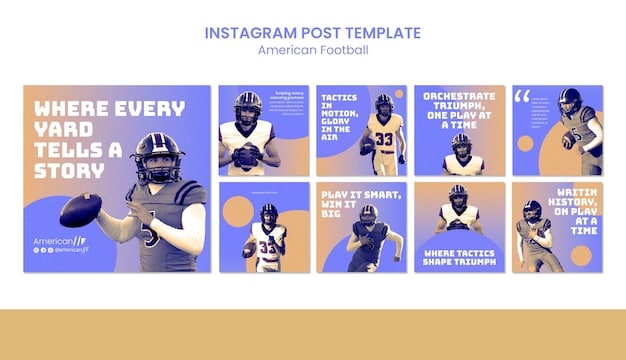Premier League Social Media Analysis: Following Trends Online

Premier League Social Media Analysis: Following the Latest News and Trends Online examines how clubs leverage digital platforms to engage fans, share updates, and build their brand presence in the ever-evolving landscape of online interaction.
Staying on top of the Premier League isn’t just about watching the games; it’s also about following the digital conversations. This Premier League Social Media Analysis: Following the Latest News and Trends Online dives into how teams connect with fans, what strategies work best, and what’s new in the world of football social media.
Why Social Media Matters for the Premier League
Social media is no longer just an add-on for Premier League clubs; it’s a core part of their strategy for building a global fanbase and staying relevant. The importance of these platforms extends far beyond simple updates.
Let’s explore why it matters:
Enhancing Fan Engagement
Social media provides a direct line between clubs and their fans, allowing for real-time interaction and a sense of community.
Global Reach and Brand Building
Clubs can use platforms like Twitter, Instagram, and Facebook to connect with fans all over the world, something traditional media can’t always achieve.
- Expanding Market Presence: Social media allows clubs to tap into new and emerging markets, increasing their global footprint.
- Attracting Sponsors: A strong online presence can attract lucrative sponsorship deals, boosting revenue for clubs.
- Building Brand Loyalty: Consistent and engaging content fosters a stronger connection with fans, leading to increased loyalty and support.
Premier League clubs are increasingly aware of the power of social media as a tool for global brand-building. The ability to connect with fans across different continents and cultures is invaluable for expanding their reach and influence.

Key Social Media Platforms Used by Premier League Clubs
Premier League clubs leverage a variety of social media platforms to connect with fans and share content. Each platform offers unique opportunities for engagement and brand building, catering to different segments of the audience.
Here’s a look at the key platforms and how they’re used:
Twitter for Real-Time Updates
Twitter is the go-to platform for live match updates, breaking news, and quick announcements.
Instagram for Visual Storytelling
Instagram is perfect for sharing visually appealing content, such as behind-the-scenes photos, player portraits, and match highlights.
Facebook for Community Building
Facebook allows clubs to create engaging communities, share longer-form content, and promote events and merchandise.
- YouTube for Video Content: Clubs use YouTube to host match highlights, interviews, documentaries, and other video content.
- TikTok for Short Form Entertainment: TikTok is gaining popularity for short, engaging videos that appeal to younger audiences.
- LinkedIn for Professional Networking: While less common, some clubs use LinkedIn for corporate communications and recruitment.
The choice of social media platforms often depends on the target audience and the type of content being shared. Premier League clubs typically have a presence on multiple platforms to maximize their reach and engagement.
Content Strategies That Work
Creating compelling content is essential for engaging fans and growing a club’s social media following. Strategies need to be tailored to each platform to maximize effectiveness.
Here are some strategies that work:
Behind-the-Scenes Access
Fans love to see what goes on behind the scenes, from training sessions to player interactions.
Interactive Content
Polls, quizzes, and Q&A sessions with players can boost engagement and create a sense of community.
Premier League clubs are known for:
- Match Highlights and Analysis: Short video clips of key moments, often with commentary from experts.
- Player Interviews: Exclusive interviews with players, providing insights and personal stories.
- Fan Features: Highlighting fan stories, photos, and videos to build community and loyalty.
The key is to strike a balance between promoting the club and providing valuable, entertaining content that fans will enjoy and share. Premier League clubs need to continually innovate and adapt their content strategies to stay ahead of the competition.

Analyzing Engagement Metrics
Engagement metrics are crucial for evaluating the success of social media strategies. By tracking metrics like likes, shares, and comments, clubs can understand what content resonates with their audience and refine their approach accordingly.
Here’s what they measure:
Reach and Impressions
Reach refers to the number of unique users who see a piece of content, while impressions are the total number of times the content is displayed.
Engagement Rate
Engagement rate measures the percentage of users who interact with a post, such as liking, commenting, or sharing.
Common benchmarks include:
- Video Views: Monitoring the number of views on video content to gauge its popularity.
- Website Traffic: Tracking the amount of traffic driven from social media to the club’s website.
- Sentiment Analysis: Analyzing the tone of comments and mentions to understand fan sentiment towards the club.
Premier League clubs use a variety of tools to track and analyze their social media performance. These insights help to optimize content strategies and improve overall engagement.
Challenges and Pitfalls
Managing social media for a Premier League club comes with its own set of challenges and potential pitfalls. It’s essential to have a proactive strategy for handling these issues.
The common challenges include:
Dealing with Negative Comments
Social media can be a breeding ground for negativity, and clubs need to have a plan for addressing inappropriate or offensive comments.
Maintaining Authenticity
It’s crucial to strike a balance between promoting the club and maintaining an authentic voice that resonates with fans.
- Avoiding Public Relations Disasters: Clubs need to be careful about the messages they send and avoid anything that could damage their reputation.
- Keeping Up with Trends: Social media is constantly evolving, and clubs need to stay on top of the latest trends and technologies.
- Managing Player Accounts: Ensuring that players are responsible and professional on social media is essential.
Premier League clubs invest heavily in social media management and training to minimize these risks and maintain a positive online presence. Having a well-defined social media policy and a dedicated team for monitoring and moderation is crucial.
The Future of Premier League Social Media
The future of Premier League social media is likely to be shaped by emerging technologies and changing fan behaviors. Clubs need to be prepared to adapt and innovate to stay ahead of the game.
Future trends include:
Integration of Augmented Reality
AR could be used to create immersive experiences for fans, such as virtual stadium tours or interactive games.
Personalized Content
AI could be used to deliver personalized content to individual fans based on their interests and preferences.
Key Predictions:
- Increased Use of AI: Artificial intelligence will play a bigger role in content creation, analytics, and fan engagement.
- More Focus on Video: Video content will continue to dominate social media, with a growing emphasis on short-form videos.
- Expansion into New Platforms: Clubs will explore new and emerging platforms to reach a wider audience.
Premier League clubs need to invest in new technologies and talent to capitalize on these trends and maintain a competitive edge in the digital landscape.
| Key Aspect | Brief Description |
|---|---|
| ⚽ Fan Engagement | Enhancing interaction through real-time updates & community building. |
| 🌎 Global Reach | Expanding market presence worldwide using varied platforms. |
| 📈 Metric Analysis | Tracking reach, engagement rates, and sentiment for improvement. |
| 📱 Content Strategy | Balancing promotions with engaging fan-centric content. |
Frequently Asked Questions
▼
Premier League clubs frequently use platforms like Twitter, Instagram, Facebook, and YouTube to connect with fans, share news, offer updates, and distribute different content types aimed at engaging their audience.
▼
Clubs engage with fans through interactive content like polls, Q&A sessions with players, and by sharing behind-the-scenes glimpses. Highlighting fan content and stories also fosters community engagement
▼
Clubs measure their engagement success by tracking metrics such as reach, impressions, engagement rate (likes, shares, comments), video views, website traffic driven from social media, and conducting sentiment analysis.
▼
Challenges include handling negative comments, maintaining authenticity, avoiding public relations disasters, keeping up with fast-evolving trends, and ensuring player accounts uphold privacy and professionalism standards.
▼
Future trends are expected to include the integration of augmented reality for immersive fan experiences, personalized content delivery powered by AI, a growing emphasis on short-form video content, and exploring new and emerging social platforms.
Conclusion
In conclusion, mastering social media is crucial for Premier League clubs looking to engage fans, build their brand, and stay competitive. By leveraging the right platforms, creating compelling content, and analyzing engagement metrics, clubs can maximize their online presence and achieve their strategic goals. As social media continues to evolve, Premier League clubs must adapt and innovate to remain at the forefront of digital engagement.





